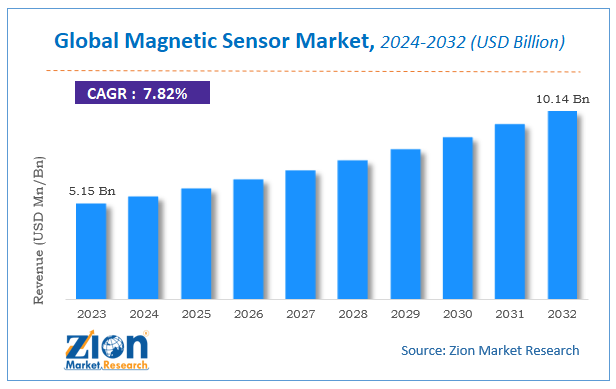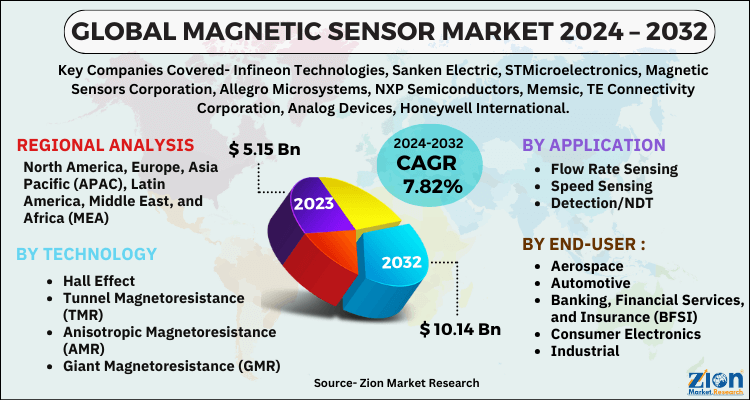Magnetic Sensor Market Size Report, Industry Share, Analysis, Growth, 2032

Magnetic Sensor Market by Technology (Hall Effect, Tunnel Magnetoresistance (TMR), Anisotropic Magnetoresistance (AMR), Giant Magnetoresistance (GMR), and Others), by Application (Flow Rate Sensing, Speed Sensing, Detection/NDT, Navigation and Electronic Compass, Position Sensing and Others) by End-user (Aerospace, Automotive, Banking, Financial Services, and Insurance (BFSI), Consumer Electronics, Industrial, and Others) - Global Industry Perspective, Comprehensive Analysis and Forecast, 2024-2032
| Market Size in 2023 | Market Forecast in 2032 | CAGR (in %) | Base Year |
|---|---|---|---|
| USD 5.15 Billion | USD 10.14 Billion | 7.82% | 2023 |
Magnetic Sensor Industry Prospective:
The global magnetic sensor market size was worth around $5.15 Billion in 2023 and is predicted to grow to around $10.14 Billion by 2032 with a compound annual growth rate (CAGR) of roughly 7.82% between 2024 and 2032
The report covers forecast and analysis for the magnetic sensor market on a global and regional level. The study provides historic data of 2016-2018 along with a forecast from 2024 to 2032 based on revenue (USD Billion). The study includes drivers and restraints for the magnetic sensor market along with the impact they have on the demand over the forecast period. Additionally, the report includes the study of opportunities available in the magnetic sensor market on a global level.
This report offers comprehensive analysis on global magnetic sensor along with, market trends, drivers, and restraints of the market. This report includes a detailed competitive scenario and Product Portfolio of key vendors. To understand the competitive landscape in the market, an analysis of Porter’s five forces model for the market has also been included. The study encompasses a market attractiveness analysis, wherein all segments are benchmarked based on their market size, growth rate, and general attractiveness. This report is prepared using data sourced from in-house databases, secondary and primary research team of industry experts.
Key Market Drivers:
- Seamless Display Rotation: Magnetic sensors provide seamless rotation to smartphones, tablets, and laptop screens. Magnetic sensors constantly sense the position of the gadget, acting as undetectable levelers, which is expected to fuel the demand for magnetic sensors. It also makes it possible for the display to instantly flip between portrait and landscape orientation when the user tilts it, offering a simple and comfortable viewing experience regardless.
- Magnetocardiography (MCG): The non-invasive technology examines faint magnetic fields produced by the heart’s electrical activity using extremely sensitive magnetic sensors. This assists in diagnosing arrhythmias, myocardial infarctions, and other myocardial conditions even before conventional techniques can.
- Pacemakers and Implantable Cardioverter Defibrillators (ICDs): The ICDs and pacemakers use microscopic magnetic sensors to identify variations in a patient’s cardiac rhythm. This enables the gadget to modify the pace or apply a shock as required, assisting in the regulation of cardiac function and possibly saving lives, and thus it offers lucrative opportunities for magnetic sensors in the healthcare industry.
- Electric Vehicle Revolution: Magnetic sensors have new applications as a result of the move to electric vehicles. Motor Position and Speed Sensing For effective motor control and power delivery, sensors keep an eye on the position and speed of the electric motor shaft. The Battery Management System (BMS) is to ensure safe and optimal battery performance, magnetic sensors are employed in BMS to monitor temperature and battery health.
- Robustness and Reliability: Most magnetic sensors are solid-state, low-moving parts devices. Because of this, they can withstand hostile conditions, shock, and vibration, which enables dependable performance in demanding applications. For instance, even in severe weather, the magnetic sensors in anti-lock braking systems (ABS) can continue to perform as intended.
- Integration with Other Sensors: Magnetic sensors interact and connect effectively with other sensors such as Accelerometers and gyroscopes. Electronic control systems obtain a more thorough picture of the environment by combining input from several sensors. Even in situations when GPS signals are weak, magnetic sensors in navigation systems collaborate with GPS to provide precise location. Thus, the accuracy and connectivity increase the adoption of magnetic sensors in the automotive industry.
Key Challenges:
- Dwindled Profit Margins: Manufacturers’ profit margins decrease if the cost of magnetic sensors drops as a result of less expensive components. Research and development (R&D) spending for fresh and enhanced magnetic sensor technologies is hindered as a result. Reduced innovation results in a stagnant market and slower growth.
- Price Sensitivity: The decrease in the cost of sensors and semiconductors, increases the entry of new competitors in the market and increases the competition in the market with more manufacturers and identical products. To secure contracts, companies also put lower pricing ahead of features or performance. A race to the bottom where all sensors become commodities with little difference could result from this.
- Disruptions to the Worldwide Supply Chain: The pandemic significantly affected the worldwide supply chain for electrical components, which included the raw materials and parts required for magnetic sensors. Production was halted and shortages resulted from lockdowns in important manufacturing hubs such as China, Taiwan, and South Korea. This made magnetic sensors less accessible to a wider range of sectors.
Key Trends:
- Deployment of Electric Vehicles (EVs) and Advanced Driver Assistance Systems (ADAS): One of the main markets for magnetic sensors is the automobile sector. High-precision magnetic sensors are required for ADAS features such as lane departure warning, steering angle detection, wheel speed detection, and motor position and speed sensing in electric vehicles (EVs) due to the increasing demand for these capabilities. Thus, the adoption of magnetic sensors in the automotive industry is expected to boost during the forecast period.
- Miniaturization and Integration: Smaller and more energy-efficient magnetic sensors are required as wearable electronics and the Internet of Things (IoT) gain traction. The goal of manufacturers is to integrate magnetic sensors with other sensing technologies like gyroscopes and accelerometers while also making magnetic sensors smaller. The creation of small, feature-rich devices for a range of applications, is expected to act as a trend for the magnetic sensor.
- Magnetic Sensors Fusion and Advanced Data Analytics: The integration of data from various magnetic sensors with other sensor types, such as cameras and LiDAR, is becoming more and more popular. This process is known as magnetic sensor fusion and advanced data analytics. When combined with sophisticated data analytics, this sensor fusion enables a more thorough awareness of the surroundings. Applications in robotics, industrial automation, and driverless vehicles will find this trend especially pertinent.
Magnetic Sensor Market: Segmentation
Worldwide magnetic sensor market is segmented on the basis of technology, application, end-user, and region.
The technology segment is further classified into Hall Effect, Tunnel Magnetoresistance (TMR), Anisotropic Magnetoresistance (AMR), Giant Magnetoresistance (GMR), and others.
On the basis of application, the market is primly categorized into flow rate sensing, speed sensing, detection/ndt, navigation and electronic compass position sensing and others.
End-user segment is includes aerospace, automotive, Banking, Financial Services, and Insurance (BFSI), consumer electronics, industrial, and others.
Magnetic Sensor Market: Report Scope
| Report Attributes | Report Details |
|---|---|
| Report Name | Magnetic Sensor Market |
| Market Size in 2023 | USD 5.15 Billion |
| Market Forecast in 2032 | USD 10.14 Billion |
| Growth Rate | CAGR of 7.82% |
| Number of Pages | 162 |
| Key Companies Covered | Infineon Technologies, Sanken Electric, STMicroelectronics, Magnetic Sensors Corporation, Allegro Microsystems, NXP Semiconductors, Memsic, TE Connectivity Corporation, Analog Devices, Honeywell International, Asahi Kasei Microdevices, and Texas Instruments, Inc. among others |
| Segments Covered | By Technology, By Application, By End-User and By Region |
| Regions Covered | North America, Europe, Asia Pacific (APAC), Latin America, Middle East, and Africa (MEA) |
| Base Year | 2023 |
| Historical Year | 2018 to 2022 |
| Forecast Year | 2024 - 2032 |
| Customization Scope | Avail customized purchase options to meet your exact research needs. Request For Customization |
Based on geography the market is segment into North America, Europe, Latin America, Asia Pacific, and MEA. All the segments have been analyzed based on present and future trends and the market is estimated from 2024 to 2032. The regional segmentation includes the current and forecast demand for North America, Europe, Asia Pacific, Latin America, and Middle East and Africa. Each region has been further segmented into countries such as the U.S., Canada, Mexico, UK, France, Germany, Italy, Spain, China, India, Japan, Australia, South Korea, Brazil, Argentina, Saudi Arabia, UAE, and South Africa, among other countries.
Magnetic Sensor Market: Competitive Space
The report covers detailed competitive outlook including the market share and company profiles of the key participants operating in the global magnetic sensor market such as
- Infineon Technologies
- Sanken Electric
- STMicroelectronics
- Magnetic Sensors Corporation
- Allegro Microsystems
- NXP Semiconductors
- Memsic
- TE Connectivity Corporation
- Analog Devices
- Honeywell International
- Asahi Kasei Microdevices
- Texas Instruments. Inc.
- among others.
The report segments the magnetic sensor market as follows:
Magnetic Sensor Market: Technology Segment Analysis
- Hall Effect
- Tunnel Magnetoresistance (TMR)
- Anisotropic Magnetoresistance (AMR)
- Giant Magnetoresistance (GMR)
- Others
Magnetic Sensor Market: Application Segment Analysis
- Flow Rate Sensing
- Speed Sensing
- Detection/NDT
- Navigation and Electronic Compass
- Position Sensing
- Others
Magnetic Sensor Market: End-user Segment Analysis
- Aerospace
- Automotive
- Banking, Financial Services, and Insurance (BFSI)
- Consumer Electronics
- Industrial
- Others
Magnetic Sensor Market: Regional Segment Analysis
- North America
- The U.S.
- Europe
- UK
- France
- Germany
- Asia Pacific
- China
- Japan
- India
- Latin America
- Brazil
- Middle East and Africa
Table Of Content
Methodology
FrequentlyAsked Questions
A device that can detect and measure the presence of magnetic fields, as well as their strength and the direction in which they are directed, is known as a magnetic sensor. These sensors make use of a variety of technologies in order to transform changes in magnetic fields into electrical signals that electronic systems are able to analyse and interpret.
Innovations in Technology: Innovations in sensor technology, such as better sensitivity, accuracy, and power efficiency, can drive market expansion by enabling the creation of more sophisticated and adaptable magnetic sensors that can be used for a variety of applications. This can in turn lead to an increase in demand for these sensors.
The Global Magnetic Sensor Market Size Was Worth $XX billion in 2018 and Is Expected To Reach $XX billion by the end of 2025, CAGR of XX%
The regional segmentation includes the current and forecast demand for North America, Europe, Asia Pacific, Latin America, and Middle East and Africa. Each region has been further segmented into countries such as the U.S., Canada, Mexico, UK, France, Germany, Italy, Spain, China, India, Japan, Australia, South Korea, Brazil, Argentina, Saudi Arabia, UAE, and South Africa, among other countries.
The report covers detailed competitive outlook including the market share and company profiles of the key participants operating in the global magnetic sensor market such as Infineon Technologies, Sanken Electric, STMicroelectronics, Magnetic Sensors Corporation, Allegro Microsystems, NXP Semiconductors, Memsic, TE Connectivity Corporation, Analog Devices, Honeywell International, Asahi Kasei Microdevices, and Texas Instruments, Inc. among others.
HappyClients
Zion Market Research
Tel: +1 (302) 444-0166
USA/Canada Toll Free No.+1 (855) 465-4651
3rd Floor,
Mrunal Paradise, Opp Maharaja Hotel,
Pimple Gurav, Pune 411061,
Maharashtra, India
Phone No +91 7768 006 007, +91 7768 006 008
US OFFICE NO +1 (302) 444-0166
US/CAN TOLL FREE +1 (855) 465-4651
Email: sales@zionmarketresearch.com
We have secured system to process your transaction.
Our support available to help you 24 hours a day, five days a week.
Monday - Friday: 9AM - 6PM
Saturday - Sunday: Closed







